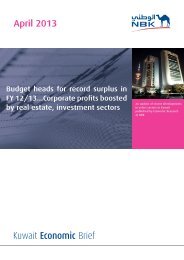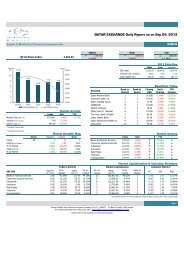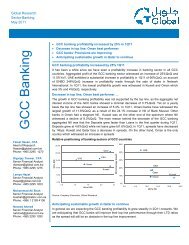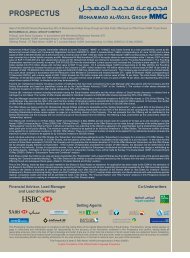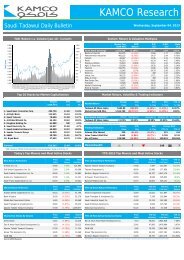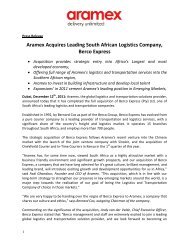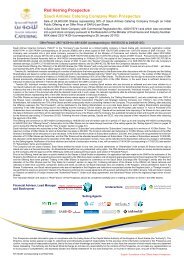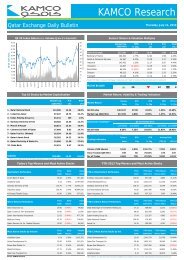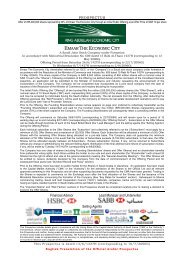The Non-Oil and Gas SectorThe Non-Oil and Gas sector contributed 40.4% of total GDP in 2005, recording a growth of 18.8% over2004. The main components of this sector are the following:a. Manufacturing IndustryIn 2005, the Manufacturing sector made the largest contribution to GDP among non-oil andgas sectors. This sector grew by 8.7% at current prices, contributing QR 13,042 million, whichrepresented 8.4% of total GDP. This sector is strongly supported by the Government as a partof a general policy to diversify income sources and to maximise the utilisation of <strong>Qatar</strong>’s naturalresources.The major sub-sectors of the Manufacturing sector are petroleum refining, industrial, chemicals,fertilisers and steel, which utilise natural gas as feed-stock and/or fuel. Other important activitiesinclude the production of flour, cement, concrete, plastics, textiles and footwear, household articlesand paint.b. Other ServicesThe Other Services sector, which includes government services, social services, householdservices, imputed bank service charges and import tariffs, made the second largest contribution toGDP of the non-oil and gas sectors, and in 2005 contributed QR 11,514 million (representing 7.4%of total GDP).c. Building and ConstructionThe rapid pace of developments in the Building and Construction sector is quite evident aroundDoha over the past few years, and as such this sector continues to be a major contributor tothe GDP and employment of labour force. This sector witnessed a growth of 36.1% in 2005,contributing QR 8,744 million to overall GDP. Credit facilities extended by commercial banksto the land, housing and construction sector increased by 67.0% during the year 2005 toreach QR 9,541 million, compared to QR 5,712 million in 2004. During the first half of <strong>2006</strong>,credit facilities to this sector grew by a further 25.8% to reach QR 12,000 million. Anothermajor indicator showing the level of activity in the building and construction sector is the numberof building permits issued. In 2005, the number of building permits issued increased by 23.4% toreach 5,950 (Table 2.3).Table 2.3Building permitsissued byMunicipality(2001-2005)Municipality 2001 2002 2003 2004 2005Doha 1,545 1,579 1,581 1,930 2,082Al-Rayyan 1,305 1,418 1,372 1,741 2,373Wakrah 184 217 262 302 407Umm Slal 369 468 409 586 700Al-Khor 153 192 287 262 388Total 3,556 3,874 3,911 4,821 5,950Source: The Planning Council.Public expenditure is a very important factor affecting the prospects for the building andconstruction sector, and the realisation of budgetary surpluses in the last six fiscal yearshas increased the level of public spending. Allocation for major public projects in the<strong>2006</strong>/07 Budget increased by 70.5% to reach QR 20.0 billion, which covers the areasof public services, infrastructure, social and health services, and education and youthwelfare.THE ECONOMY OF QATAR 12
d. Real Estate and Business ServicesThe Real Estate and Business Services sector made the fourth largest contribution to GDP ofQR 7,672 million. This sector witnessed a strong growth of 24.2% in 2005 and represented 5.0%of <strong>Qatar</strong>’s total GDP.e. Finance and InsuranceThe Finance and Insurance sector is comprised of three sub-sectors: banking, insurance andfinancial intermediation services. This sector has witnessed the most rapid growth in 2005,increasing by 89.8% and contributing QR 7,113 million to the overall GDP in 2005. This sectorrepresented 4.6% of <strong>Qatar</strong>’s total GDP in 2005.f. Trade, Restaurants and HotelsThe Trade, Restaurants and Hotels sector contributed QR 6,869 million to <strong>Qatar</strong>’s overall GDPin 2005, representing 4.4% of total GDP. This sector grew by 11.7% in 2005 and will be oneof the most promising in the coming years, as business, cultural, sports, education and tourismevents aimed at promoting <strong>Qatar</strong>, gathers even more momentum. The upcoming Asian Games inDecember <strong>2006</strong> will also have a very positive impact on the tourism industry. <strong>Qatar</strong>’s hotel roomcapacity in the luxury sector is expected to increase by an additional 9,318 rooms in the comingyears as a result of up-coming projects such as the West Bay Resort, the Doha Hilton, the Shangri-La, the Renaissance, the Al-Sharq Village Resort & Spa, La Cigale, the Marriott Courtyard and theRotana amongst others. The <strong>Qatar</strong> Tourism Authority which was established in the year 2000, isactively promoting <strong>Qatar</strong> as a tourist destination.g. Transport and CommunicationsThis sector contributed QR 5,114 million to the overall GDP in 2005, and witnessed a growth of27.2%. <strong>Qatar</strong> Airways is the principal airline operating from <strong>Qatar</strong>, designated as the “NationalCarrier”, and is a joint public and private sector enterprise (being 50% owned by the Government).In 2005, <strong>Qatar</strong> Airways carried over 6 million passengers and ranked 2nd in the region. It currentlyflies to over 70 destinations in the Middle East, North Africa, Europe, the Indian sub-continent andthe Far East. <strong>Qatar</strong> Airways operates an all-Airbus fleet of 45 aircraft and will triple its fleet to 110by 2015.<strong>Qatar</strong> Telecom (Q-Tel) under licence, is currently the sole telecommunications service provider in<strong>Qatar</strong>. Rapid growth in wireless communications has seen Q-Tel’s GSM subscriber numbers risesubstantially, and by the first half of the year <strong>2006</strong> had over 800,000 subscribers, which translatesinto a 93% penetration level, one of the highest in the region. Q-Tel has also expanded its operationsin the region, with the successful bid in 2005 to become the second mobile operator (NawrasTelecom) in Oman.h. Electricity and WaterThe Electricity and Water sector witnessed a growth of 49.0% in 2005, contributing QR 2,209million to <strong>Qatar</strong>’s overall GDP. Most of <strong>Qatar</strong>’s electricity generation capacity comprises of gasturbines, which are fuelled by natural gas. Water desalination is achieved in tandem with electricitygeneration. Ras Abu Fontas-B Plant, <strong>Qatar</strong>’s largest power and water desalination plant, enteredoperation in 1996 and provides installed capacity of 610 megawatts.A number of industrial companies, such as QAPCO and QAFCO, have their own electricitygenerating facilities. <strong>Qatar</strong>’s first independent water and power project (IWPP) became operationalin March 2004 at Ras Laffan and has a capacity of 750 MW of power and 40 million gallons of watera day. The Ras Laffan B IWPP was completed in June <strong>2006</strong> and will start full commercial operationsin 2008. The project will add a further 680 MW of power and 15 million gallons of water a day.i. Agriculture and FisheriesThe Agriculture and Fishing sector has traditionally played only a minor role in the modern <strong>Qatar</strong>ieconomy because of unsuitable weather and environmental conditions. Cultivable land accountsfor only approximately 0.7% of <strong>Qatar</strong>’s total surface area. This sector grew by a marginal 2.9% in2005, contributing QR 216 million to <strong>Qatar</strong>’s GDP.THE ECONOMY OF QATAR 13



